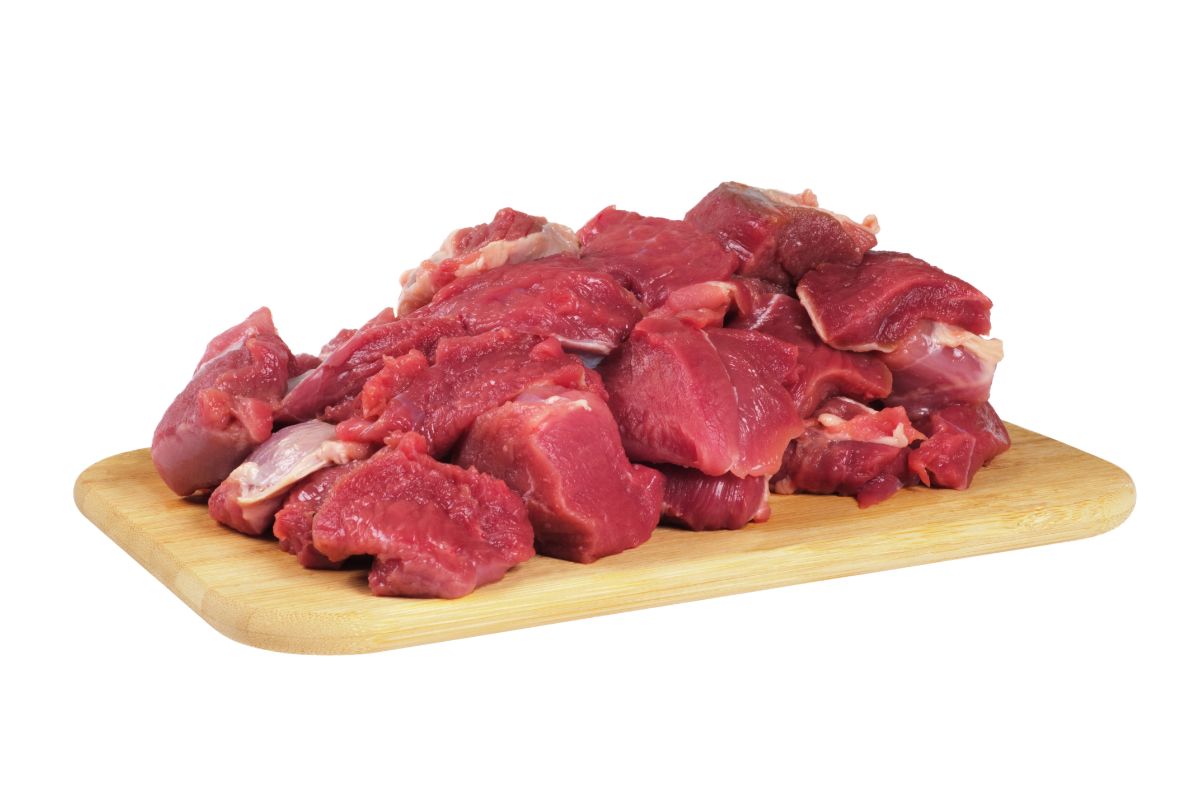Mutton is a type of meat derived from the flesh of mature sheep. It has a strong, gamey flavor that is often compared to beef, although it can be more tender and flavorful than other meats.

Though it is not as popular in the United States as it once was, mutton remains an important part of many cuisines around the world, offering unique flavors and textures for a variety of dishes.
Mutton is usually sold in large cuts, such as chops or roasts, and is well suited for slow cooking methods like braising or stewing. Ground mutton can also be used in dishes like shepherd’s pie or kofta kebabs.
We took a closer look at the history, flavor, and uses of mutton to help you decide if it’s a good choice for your next meal.
What Is Mutton?
Mutton has been a part of culinary traditions around the world for centuries. It is a staple of Middle Eastern and Indian cuisine, where it is often served as kebabs or curries.
Mutton’s strong flavor means that it is best used in dishes that have plenty of spices or sauces to balance it out. In the United States, mutton was once a popular choice for Sunday roasts, but it has since fallen out of favor with the public.
Mutton is the meat of a sheep that is over two years old. This makes it tougher than lamb, which comes from younger animals and gives it a stronger flavor.
The fat content of mutton can vary depending on the breed and age of the animal but generally ranges from 15 to 25 percent.
What Are The Health Benefits Of Mutton?
Mutton is a nutrient-rich food that can offer many health benefits, some of which include:
High In Protein
A key advantage of mutton is that it is a good source of protein. A 4-ounce serving contains 14 grams of protein, which helps to support healthy muscles and bones.
Good Source Of Vitamin B12
Mutton is rich in vitamin B12, which plays an important role in cell metabolism and energy production. Just one serving contains 25 percent of the daily recommended value for this essential nutrient.
Rich In Iron
Mutton is an excellent source of iron, offering 3.2 milligrams per 4-ounce serving. This mineral is essential for red blood cell production and can help to prevent anemia.
Rich In Zinc
Mutton contains 2.1 milligrams of zinc per 4-ounce serving, which helps to support the immune system and metabolism.
Low In Fat
Mutton is low in fat, with a 4-ounce serving containing just 5.5 grams. This makes it an ideal choice for those looking to reduce their overall fat intake.
Rich In Omega-3 Fatty Acids
Mutton is also rich in omega-3 fatty acids, which are beneficial for heart health and can help to reduce inflammation.
Rich In Amino Acids
Mutton is also a good source of essential amino acids like lysine and tryptophan, which are important for muscle growth and repair. This also makes it a great choice for athletes and fitness enthusiasts.
How To Cook Mutton
Mutton is best cooked slowly over low heat to allow the flavors to develop and the tough fibers to break down.
This can be done either in an oven or on the stovetop, with popular methods including braising, stewing, or slow roasting. Ground mutton can also be used in dishes like shepherd’s pie or kofta kebabs.
Before Cooking
Cooking mutton properly is a real process, and there are two essentials that you will need to carry out before you think about the meat (see also: What Is Capicola?)touching the heat: tenderizing and marinating.
Tenderizing
Tenderizing refers to pounding the meat with a mallet or tenderizing tool. This helps to break down the tough fibers and connective tissue and make it more tender when cooked.
Marinating
Marinating is another way to soften the meat and add flavor. There are many different marinades that you can use, but some of the most popular include garlic, red wine vinegar, yogurt, lemon juice, and olive oil.
How To Cook
Once the meat is prepared, you can move on to cooking – and this includes choosing the right flavors to accompany the dish.

Mutton has a strong flavor, which can be balanced out by adding various spices or sauces, (see also: Ranchero Sauce)and popular seasonings for mutton include:
Garlic
Garlic is a great addition to any mutton dish, as it helps to bring out the natural flavors of the meat.
Onion
Onions add a sweetness that can help to balance out the strong flavor of mutton.
Cumin
Cumin has a warm and earthy flavor that pairs well with mutton and is often used in Indian dishes.
Coriander
Coriander adds a fragrant and citrusy flavor and is another popular option for mutton dishes.
Turmeric
Turmeric is a great way to add a subtle flavor to your dish, as well as an appetizing yellow color.
Methods Of Cooking
Mutton can be cooked in a variety of ways, depending on the recipe you are following, and some of the most popular options include:
The Stovetop
Cooking mutton on the stovetop allows you to simultaneously brown the meat and cook it slowly in a sauce or liquid and is great for adding deep seasoning and flavor to your dish.
The Oven
Roasting mutton in the oven is a great way to get tender, succulent meat with a crispy crust on the outside.
Slow Cooker/Crock Pot
Cooking mutton in a slow cooker or crock pot is ideal for when you don’t have the time to stand over the stove, as it cooks slowly and evenly in its own juices.
Even better, this produces meat that is super juicy, tender, and full of flavor – this is a meal you will be looking forward to all evening!
Final Thoughts
Mutton is a delicious and versatile meat that can be used in a variety of dishes, from traditional curries to modern stews. It is rich in iron, zinc, and omega-3 fatty acids, making it an excellent source of nutrients.
If you are on the hunt for a delicious meal, mutton is definitely a great option!
Whether you choose to cook it on the stovetop, in the oven, or in a slow cooker/crock pot, you can be sure of a dish that’s full of flavor and packed with benefits for overall health.
- Dealing With Mold on Oyster Mushrooms - April 9, 2024
- What Meat Goes With Pumpkin Ravioli? (Ravishing Ravioli Combos) - March 15, 2024
- What To Dip Cheetos In? (Crunchy Cheese Puffs Concoctions) - March 4, 2024
